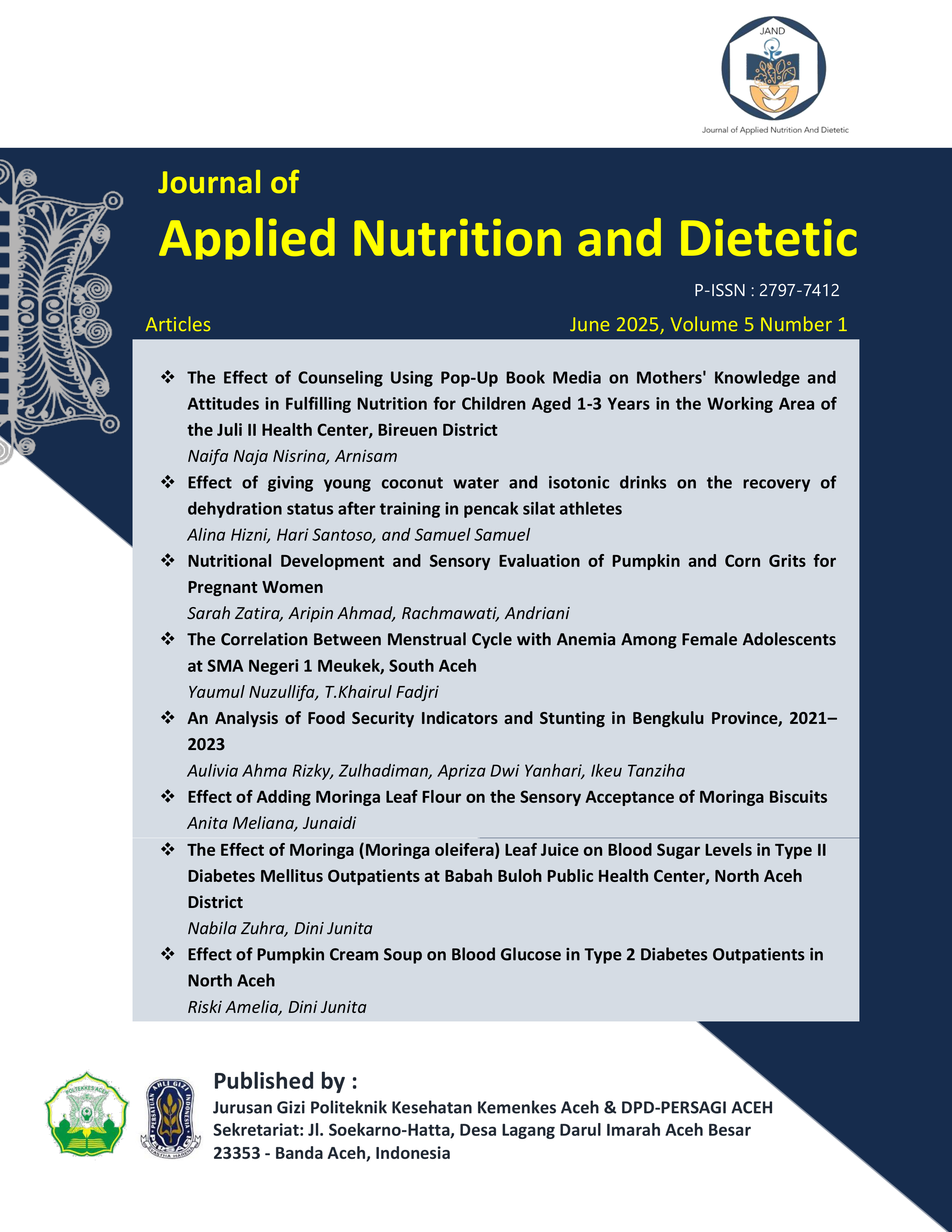An Analysis of Food Security Indicators and Stunting in Bengkulu Province, 2021–2023
DOI:
https://doi.org/10.30867/jand.v5i1.769Kata Kunci:
bengkulu province, food security index, nutrition, poverty, stuntingAbstrak
Stunting remains a significant public health concern in Bengkulu Province. According to the 2023 Indonesian Health Survey (IHS), the prevalence of stunting in Bengkulu reached 20.2%. This study analyzes the relationship between stunting and food security indicators using secondary data from the Bengkulu Central Statistics Agency and the National Food Agency from 2021 to 2023, comprising 30 samples. The analysis showed no statistically significant relationship between stunting and any of the independent variables at the 95% confidence level. The p-values for all variables—including the Food Security Index (FSI), Nutritional Consumption Pattern Ratio (NCPR), poverty rate, food and electricity expenditures, access to clean water, average years of schooling, health worker ratio, life expectancy (AHP), Desirable Dietary Pattern (DDP), Energy Adequacy Ratio (EAR), and Protein Adequacy Ratio (PAR)—were above 0.05. These findings suggest that none of the examined indicators had a significant effect on stunting in Bengkulu Province during the study period.
Referensi
Amarita, M. (2022). The relationship between expected food patterns (DDP) and the incidence of stunting in toddlers. SAGO Journal of Nutrition and Health, 3(1), 7.https://doi.org/10.30867/gikes.v3i1.300
Bapanas. (2023a). 2023 Food Security Index.
Bapanas. (2023b). Food Security and Vulnerability Map.
Basri, N., Sididi, M., & Sartika. (2021). Factors Associated with Stunting Incidence. Window of Public Health Journal, 01(05), 417–426.
Erdi Fadhilah, A., Suryanto, & Mulyanto. (2022). Analysis of the Influence of Stunting Prevalence, Poverty, and the Role of Exclusive Breastfeeding on the Human Development Index in Indonesia. Proceedings of the National Seminar of the Government Science Study Program, Galuh University, 2(1), 17–22.
Fitriyani, AR, & Sunarto, S. (2021). Energy Adequacy and Early Breastfeeding Initiation (EIB) on Stunting Incidence in Toddlers Aged 6 – 23 Months. Journal of Poltekkes Semarang, 17(1), 67–72.https://doi.org/10.31983/link.v17i1.6821
Hamfi, A.G. (1981). The funny nature of dogs. E-journal of Applied Psychology, 2(2), 38 -48. Retrieved on June 9, 2017, fromhttp://ojs.lib.swin.edu.au/index.php/fdo
Khoirudin, R. (2022). The Influence of Composite Indicators of Food Security on Indonesian Household Food Consumption. Journal of Economics Development Issues, 5(2), 66–77. https://doi.org/10.33005/jedi.v5i2.93
Masitoh, S., Nurokhmah, S., & Ronoatmodjo, S. (2023). The Correlation Between Food Insecurity Level and Stunting in Indonesia. Journal of Public Health Sciences, 13(3), 385–398. https://doi.org/10.26553/jikm.2022.13.2.385-398
Ministry of Health. (2022). Indonesian Nutritional Status Survey. https://repository.badankebijakan.kemkes.go.id/id/eprint/4855/3/Buku Saku SSGI 2022 rev 270123
Ministry of Health. (2023). Indonesian Health Survey (SKI) in Figures.https://drive.google.com/file/d/1rjNDG_f8xG6-Y9wmhJUnXhJ-vUFevVJC/view
Mumtaza, M. (2024). The Relationship between Food Security and Food Diversity with the Incidence of Stunting in Toddlers Aged 24-59 Months. Media Gizi Kesmas, 13(1), 93–101. https://doi.org/10.20473/mgk.v13i1.2024.93-101
Nabuasa, CD (2024). The Relationship between Parenting History, Diet, Nutrient IntEAR and Stunting Incidence in Children Aged 24-59 Months in Biboki Utara District, North Central Timor Regency, East Nusa Tenggara Province. Journal of PAZIH_Pergizi Pangan DPD NTT, 13(1), 58–74.
Paivio, A. (1975). Perceptual comparisons through the mind's eye. Memory & Cognition, 3, 635-647. doi:10.1037/0278-6133.24.2.225
Rahmawati, NF, Fajar, NA, & Idris, H. (2020). Social, economic factors, and utilization of integrated health posts with the incidence of stunting in toddlers of poor families receiving PKH in Palembang. Indonesian Journal of Clinical Nutrition, 17(1), 23. https://doi.org/10.22146/ijcn.49696
Sihotang, U., & Rumida. (2020). Relationship between Food Security and Nutritional Quality of Family Food Consumption (Mgp4) with Toddler Nutritional Status in Palu Sibaji Village, Pantai Labu District. Innovation Forum, 9(2), 50–59.
Supadmi, S., Laksono, AD, Kusumawardani, HD, Ashar, H., Nursafingi, A., Kusrini, I., & Musoddaq, MA (2024). Factors related to stunting of children under two years with working mothers in Indonesia. Clinical Epidemiology and Global Health, 26, 101538. https://doi.org/10.1016/j.cegh.2024.101538
Swarinastiti, D., Hardaningsih, G., & Pratiwi, R. (2018). Dominance of Vegetable Protein IntEAR as a Risk Factor for Stunting in Children Aged 2-4 Years. Diponegoro Medical Journal, 7(2), 1470–1483.
Yuliantini, E., Sukiyono, K., Yuliarso, MZ, & Sulistyo, B. (2022). Food Security and Stunting Incidences in the Coastal Areas of Indonesia. Open Access Macedonian Journal of Medical Sciences, 10(F), 454–461. https://doi.org/10.3889/oamjms.2022.9335
Unduhan
Diterbitkan
Cara Mengutip
Terbitan
Bagian
Lisensi
Hak Cipta (c) 2025 JAND: Journal of Applied Nutrition and Dietetic

Artikel ini berlisensiCreative Commons Attribution-ShareAlike 4.0 International License.











